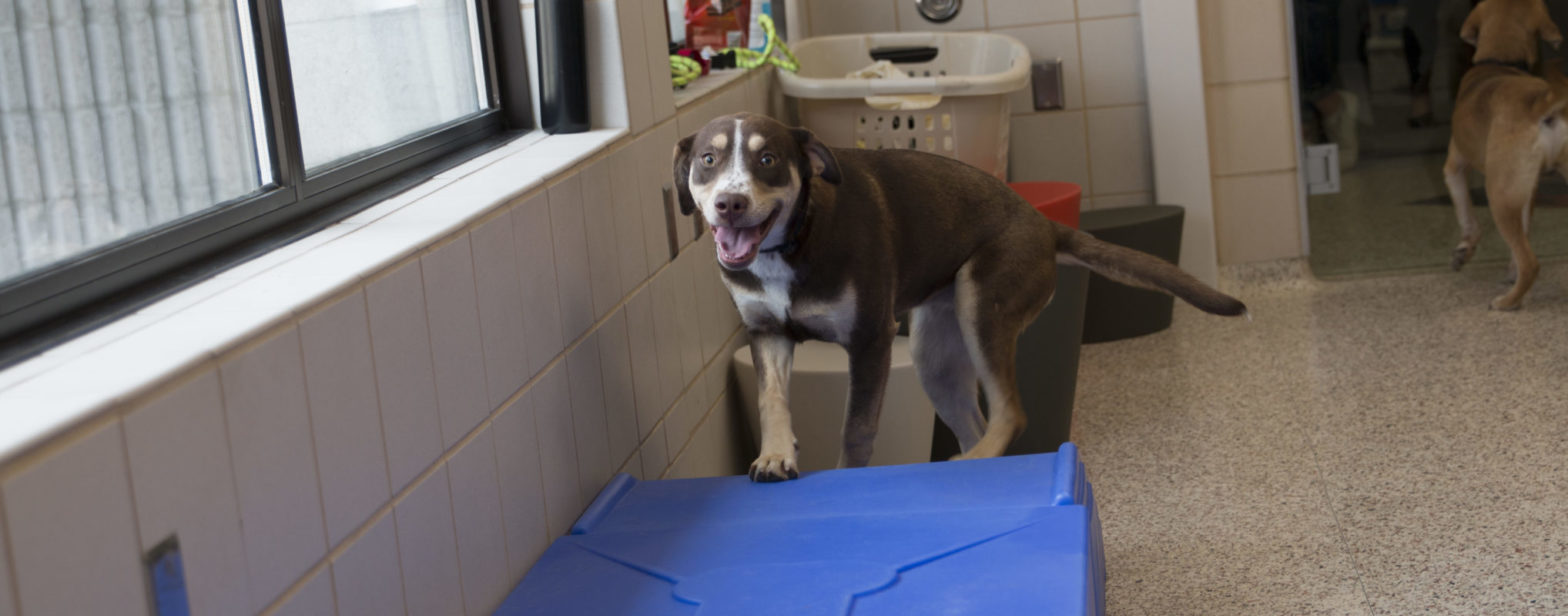My husband and I adopted our Lab mix, Rio, from an underfunded shelter in New Mexico in 2010. It was our first time visiting the facility, and the housing conditions depressed us: a few litters of puppies were crammed into chain-link cages, and adult dogs were kept alone in each small enclosure. It didn’t seem like a fun way to live. We stopped and said hello to each dog, fervently wishing we could adopt them all.
So I was excited to hear about a new shelter model that could potentially reduce fear, stress, and anxiety for dogs in animal shelters while they wait for their forever homes. The traditional design has been a series of kennels with glass or chain-link doors, with one dog per kennel.
Animal Humane Society, a nonprofit animal shelter with four locations in Minnesota’s Twin Cities, hopes to change that. The organization recently invested approximately $250,000 to design and build a habitat prototype at its Golden Valley location.
A More Stimulating Environment
Essentially, the design allows dogs to socialize throughout the day – six private “dens” with glass doors open into a large group area for play. Staff and volunteers trained in canine body language monitor the dogs nonstop throughout the day and offer rotating forms of enrichment, from puzzle games and toys to scent work.
“The ultimate goal is to provide the absolute best shelter experience for a dog,” says Janelle Dixon, CEO of Animal Humane Society. “We know that a shelter experience is not a home experience – it’s not the desired long-term place for a dog – but while they have to be there, how do we do that in the best way that supports their mental and physical needs and results in them being able to be placed in a home?”
To that end, the staff is documenting interactions between dogs and people in the habitat prototype, which opened in June 2019, to inform how to design a new shelter at their Saint Paul location, and provide information for other animal shelters seeking to reduce fear, anxiety, and stress for pets in their care. While the full results from compiled data should be available sometime this winter, Dixon says anecdotally it’s already a “wholesale success.”
Supporting Animal Wellbeing
There might be some tweaks to perfect the model, such as potentially building habitats with four dens instead of six, but the overall concept clearly supports the Five Freedoms of Animal Welfare – particularly the freedom to behave naturally, according to Dixon.
“What happens in most sheltering facilities right now is there are play groups and things like that, but dogs are spending most of their time singly in a kennel where they can hear other dogs, they can often see other dogs, they can smell other dogs, but they don’t get any opportunity to have real quality or substantive interaction,” she says. “Those kinds of things contribute to the levels of stress for dogs in shelters.”
Liv Hagen, manager of shelter behavior services at Animal Humane Society, says one anecdotal finding so far is that the model helps shy and fearful dogs through the adoption process thanks to “helper dogs.” For instance, an energetic cattle dog named Indy responded to a scared dog not by roughhousing, but by trying out different approaches to get the dog to engage with her.
First, Indy bowed. Then she went down on one shoulder in front of the shy dog and rolled over. After 10 to 15 minutes of Indy’s various overtures, something clicked, and the dogs wound up lying on the floor and gently mouthing one another.
“We saw this incredible play from this really shy, shut-down dog that we hadn’t seen before,” she recalls. “We’ve seen this time and time again: dogs helping dogs with behavioral support for each other. It’s been really remarkable.”
Margaret M. Duxbury, DVM, DACVB, a veterinary behaviorist, Fear Free Certified Professional, and partner at Veterinary Behavior Specialties of Minnesota, visited Animal Humane Society’s new habitat prototype this summer. She says the group-housed dogs showed more social behavior and fewer signs of stress or avoidance when they were together than any of the dogs viewed the same day in the traditional runs.
“With the right management in place, I think this model has great potential to reduce the stress of shelter stays,” she says.
To view a livestream of dogs living in the Animal Humane Society’s new habitat prototype, visit: https://www.animalhumanesociety.org/habitat
This article was reviewed/edited by board-certified veterinary behaviorist Dr. Kenneth Martin and/or veterinary technician specialist in behavior Debbie Martin, LVT.








